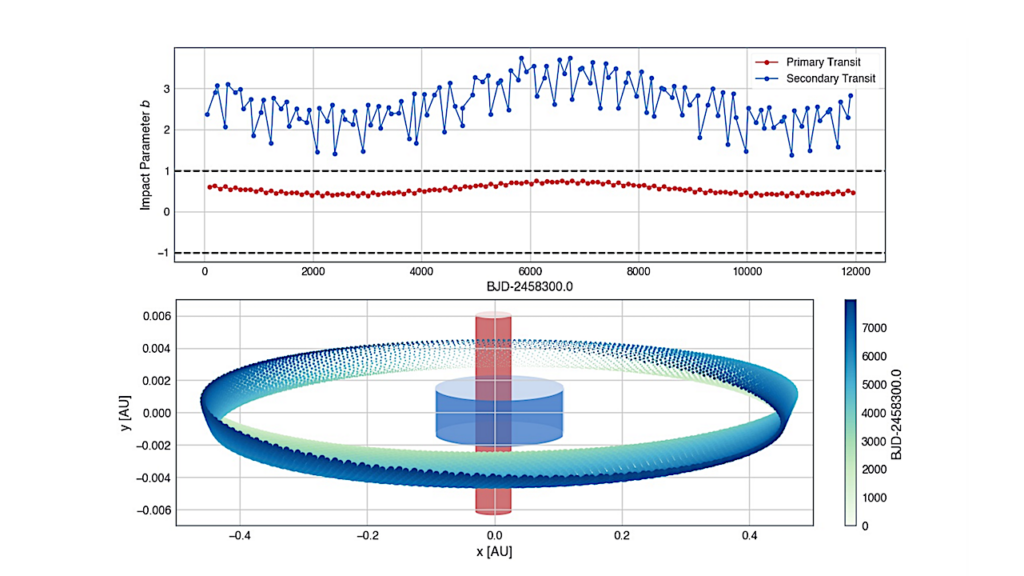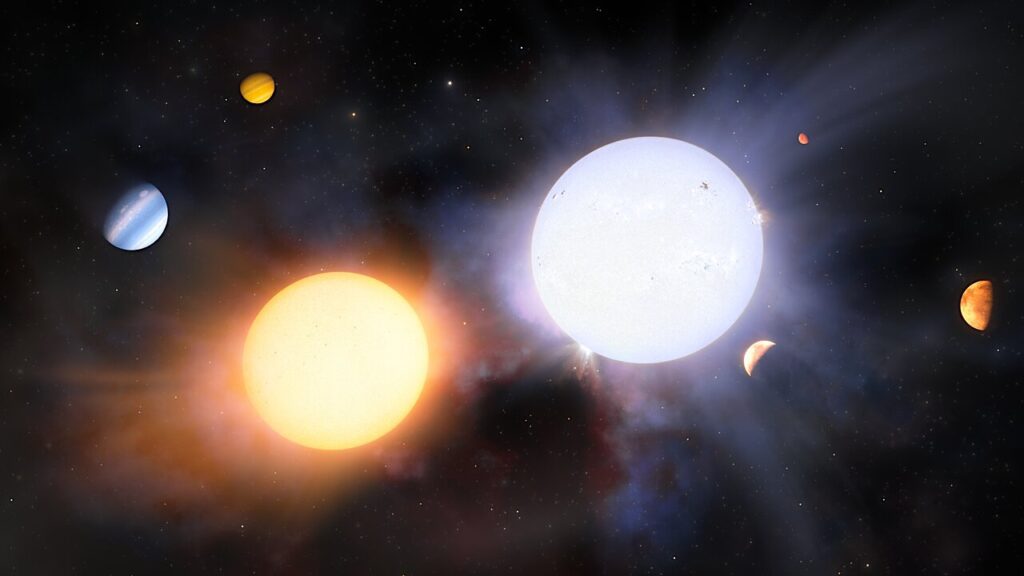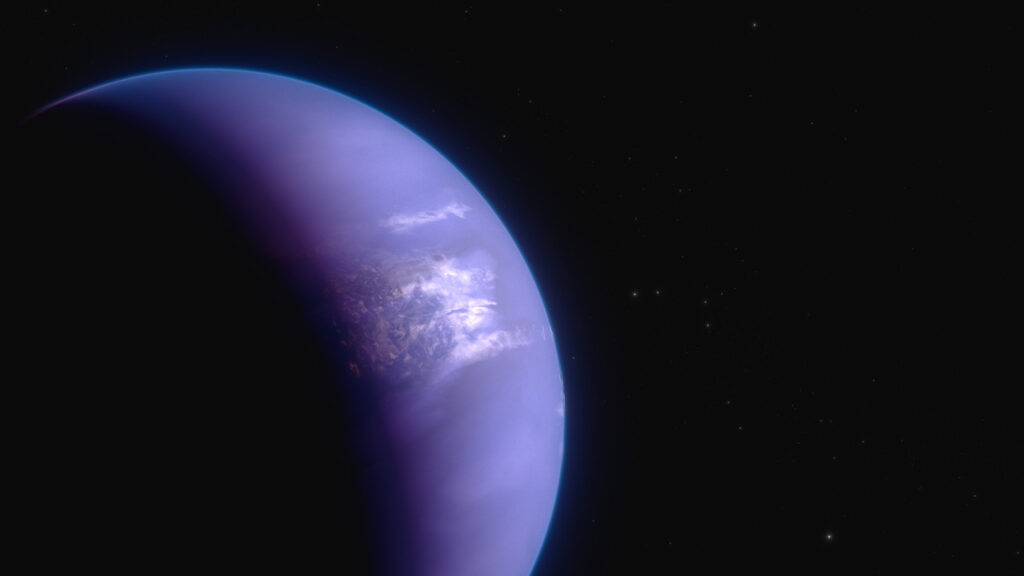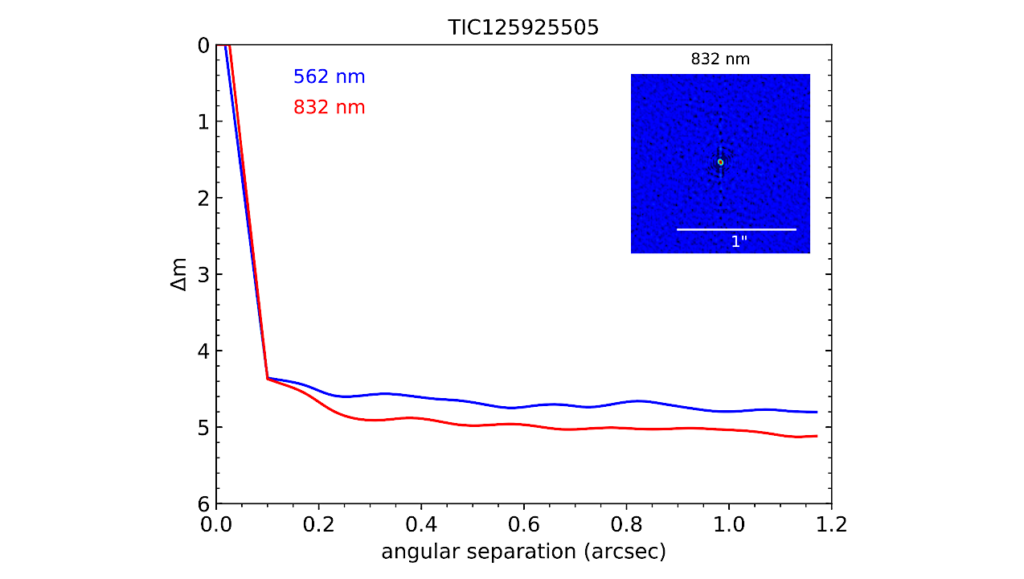Clouds Blanket The Night Side Of The Hot Exoplanet WASP-43b
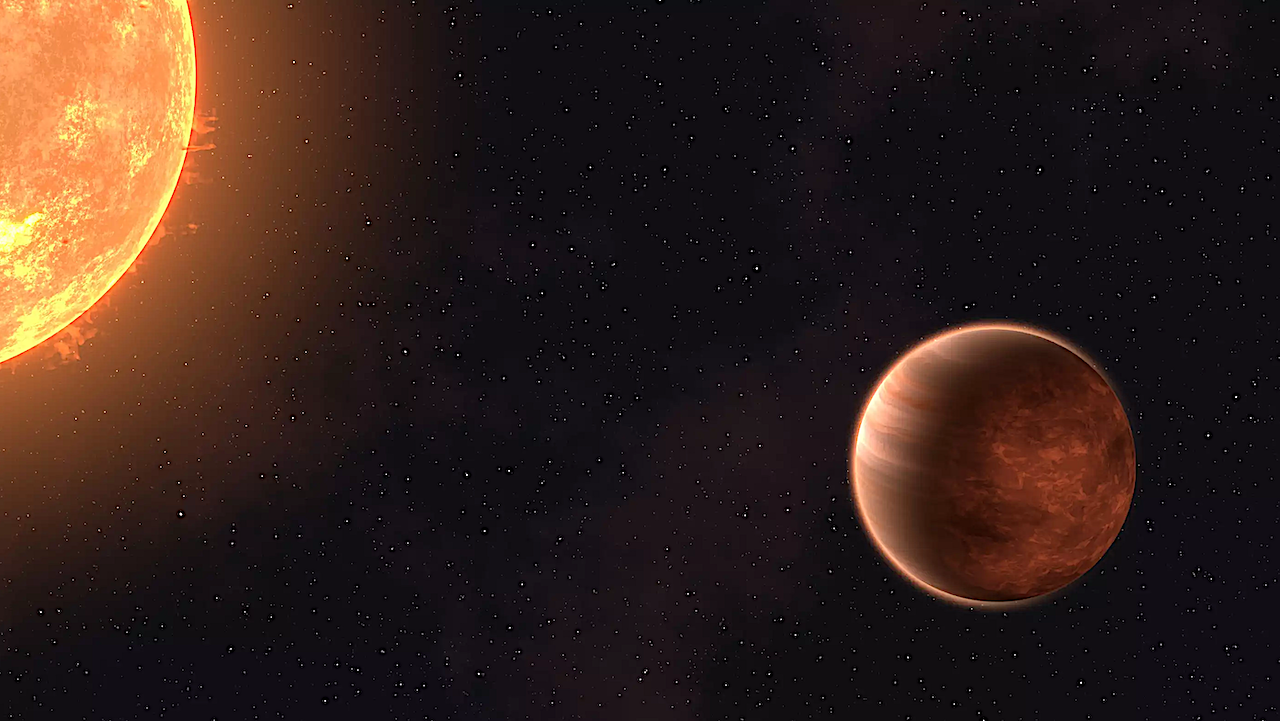
Using the James Webb Space Telescope (JWST), a team of astronomers, including scientists from MPIA, constructed a global temperature map of the hot, gas giant exoplanet WASP-43b. The nearby parent star perpetually illuminates one hemisphere, raising temperatures to a blistering 1250 degrees Celsius.
Meanwhile, eternal night shrouds the opposite side. Violent winds transport the searing hot air to the nightside, where it cools to 600 degrees, allowing clouds to form and blanket the entire hemisphere. These tempests impair chemical reactions so much that methane can barely form, even though it should be abundant under calmer conditions.
Hot Jupiters are extreme gas giant exoplanets that orbit their host stars in close proximity, leading to several exotic properties regarding temperature, density, composition, chemistry, and weather. With the advent of groundbreakingly sensitive telescopes, such as the James Webb Space Telescope (JWST), astronomers have begun to study their atmospheres in great detail.
Temperature map of the exoplanet WASP-43b — The animation shows how the perspective on the planet’s temperature distribution changes while orbiting its host star. The map is a reconstruction inferred from the measured infrared phase curve.
An international collaboration of astronomers, the JWST Transiting Exoplanet Early Release Science (JTEC-ERS) team, observed the hot Jupiter WASP-43b with JWST’s Mid-Infrared Instrument (MIRI) to study its climate. The results of that investigation led by Taylor J. Bell (BAER Institute and Space Science and Astrobiology Division, NASA Ames Research Center, USA) were published in Nature Astronomy.
An extreme world unlike anything in the Solar System
The central outcome is a map outlining the global temperature distribution derived from the infrared light WASP-43b emits in response to the irradiation by its host star. By covering a spectral range sensitive to warm materials, MIRI works similar to a non-contact thermometer used to measure body temperatures, but across large distances, amounting to 280 light-years for WASP-43b. In this map, the measured temperatures are between 600 and 1250 degrees Celsius. In contrast, using comparable observations, Jupiter, the gas giant in the Solar System, attains frosty -135 degrees.
Although similar in size and mass to Jupiter, it is a very different world. WASP-43b maintains an exceptionally tight orbit around its host star, WASP-43, travelling only two stellar diameters above the star’s surface while completing its orbit in just 19.5 hours. The small separation resulted in the day and year of the planet becoming synchronized. In other words, revolving around the star takes the same time the planet needs to rotate around its axis. Consequently, the star always illuminates and heats the same side of the planet.
Winds carry the air to the opposite hemisphere, where it cools in eternal night. However, on WASP-43b, these winds are extremely violent, with wind speeds reaching nearly 9000 kph, which is beyond anything we witness in the Solar System. In comparison, even Jupiter’s strongest winds are but a mild breeze.
Water vapour, liquid-rock clouds, and a surprising lack of methane
“With Hubble, we could clearly see that there is water vapour on the dayside. Both Hubble and Spitzer suggested there might be clouds on the nightside,” explained Taylor Bell. “But we needed more precise measurements from JWST to really begin mapping the temperature, cloud cover, winds, and more detailed atmospheric composition all the way around the planet.”
The JWST observations found the temperature contrast between the dayside and nightside to be stronger than one would expect for a cloud-free atmosphere. Model computations confirm that the planet’s nightside is shrouded in a thick layer of clouds high up in the atmosphere, which blocks much of the infrared radiation from below we would otherwise see. The exact types of clouds are still unknown. Clearly, they will not be water clouds like those on Earth, let alone the ammonia clouds we see on Jupiter, as the planet is far too hot for water and ammonia to condense. Instead, clouds made of rocks and minerals are more likely to be present at these temperatures. Hence, we should expect clouds made of liquid rock droplets. On the other hand, the hotter dayside of WASP-43b appears to be cloud-free.
To probe the atmospheric composition in more detail, the team produced spectra, i.e., they decomposed the received infrared light into tiny wavelength sections, similar to a rainbow that reveals the sunlight’s colour components. This method allowed them to identify the signatures of individual chemical compounds that radiate at specific wavelengths. As a result, the astronomers confirmed earlier measurements of water vapour, but now over the entire planet. Hubble was only able to study the day side, as the night side was too dark to recognise molecules there. JWST, with its higher sensitivity, now completes the picture.
In addition, hot Jupiters typically host large amounts of molecular hydrogen and carbon monoxide, both of which could not be probed with the team’s observations. However, when subjected to the cooler nightside, hydrogen and carbon monoxide participate in a set of reactions that would produce methane and water. However, MIRI didn’t find any methane. The astronomers explain this surprise with the enormous wind speeds on WASP-43b. The reaction partners pass the cooler nightside so quickly that there is little time left for the expected chemical reactions to produce detectable amounts of methane. Any small fraction of methane becomes thoroughly mixed with the other gases. It quickly reaches the dayside again, where it is exposed to the destructive heat.

Using the James Webb Space Telescope (JWST), the JTEC-ERS team observed the WASP-43 system continuously for 27 hours to observe the entire orbit of the hot, Jupiter-sized exoplanet WASP-43b. As the planet orbits its host star, different faces of the planet are pointed towards the telescope (shown in the top panel). As a result, they measured different temperatures depending on the proportions of the hot dayside and the cold nightside that faced the observer. Using JWST’s MIRI instrument, the team measured the temperature across the planet’s surface by applying the phase curve observing method, with MIRI working like a gigantic contactless infrared thermometer. Because the planet orbits so closely to its host star, its dayside is a scorching 1250 degrees Celsius and winds on the planet transport some of that heat to the relatively cool nightside, which is still a fiery 600 degrees. © Taylor J. Bell (BAERI/NASA) / MPIA
“With the new observing power of JWST, WASP-43b has been unveiled in unprecedented detail,” said Laura Kreidberg, Director at the Max Planck Institute for Astronomy (MPIA) in Heidelberg, Germany. She is a co-author of the underlying research article and has been exploring the planet for a decade. “We see a complex, inhospitable world, with furious winds, massive temperature changes, and patchy clouds likely made of rock droplets. WASP-43b is a reminder of the vast range of climates that are possible on exoplanets and the many ways in which Earth is special.”
WASP-43b was discovered in 2011 via the transit method. Whenever an exoplanet’s orbit is oriented so that, from our perspective, it passes in front of its host star, the occultation blocks a small portion of the starlight. These periodic drops in stellar brightness are a tell-tale sign of an object revolving around the star. The exact shape permits computing the planet’s size and orbital tilt.
Astronomers exploit a secondary effect to study the planet in detail. Consider Venus changing its illumination, resembling lunar phases, during its orbit around the Sun. Transiting exoplanets present varying phases of infrared emission in much the same way, depending on how the star heats the dayside. Observing the gradual change of proportions we see of the hot and cool hemispheres results in a characteristic pattern of how the planet’s measured infrared brightness varies in time. Analyzing this minute signal, the so-called phase curve, the astronomers received from WASP-43b allowed them to construct the temperature map and localize the gases that make up the planet’s atmosphere.
The future is infrared-bright

This image illustrates how a star illuminates and heats the dayside of a tidally locked planet orbiting in bound rotation. Similar to how we see Venus in the solar system, such a planet shows different fractions of its day and night sides, the phases, during an orbit. In observing WASP-43b, astronomers tracked the planet’s signal as a function of the degree of illumination, thereby obtaining data of the entire planet.
A follow-up study by another team led by former MPIA scientist Stephan Birkmann (European Space Agency, ESA) will look at WASP-43b with JWST’s Near-Infrared Spectrometer (NIRSpec). These measurements will be sensitive to carbon monoxide gas that should be prevalent throughout the atmosphere. In addition, the expanded wavelength coverage will improve the fidelity of the MIRI temperature map and help investigate the cloud distribution and composition more precisely.

JWST observed exoplanet WASP-43 b at various phases and obtained the 5-12 µm spectrum for each phase, revealing a day-night temperature difference of ~650 K, with low clouds at night and cloudless days.

Background information
The MPIA scientists involved in this study are Laura Kreidberg, Eva-Maria Ahrer (also University of Warwick, Coventry, UK), Sebastian Zieba (also Leiden Observatory, University of Leiden, The Netherlands [Leiden]), and Maria E. Steinrueck (now University of Chicago, USA).
Other researchers include Taylor J. Bell (BAER Institute and Space Science and Astrobiology Division, NASA Ames Research Center, Moffet Field, USA), Nicolas Crouzet (Leiden), and Patricio E. Cubillos (INAF – Osservatorio Astrofisico di Torino, Pino Torinese, Italy and Space Research Institute, Austrian Academy of Sciences, Graz, Austria).
The MIRI consortium consists of the ESA member states Belgium, Denmark, France, Germany, Ireland, the Netherlands, Spain, Sweden, Switzerland, and the United Kingdom. The national science organizations fund the consortium’s work – in Germany, the Max Planck Society (MPG) and the German Aerospace Center (DLR). The participating German institutions are the Max Planck Institute for Astronomy in Heidelberg, the University of Cologne, and Hensoldt AG in Oberkochen, formerly Carl Zeiss Optronics.
JWST is the world’s premier space science observatory. It is an international program led by NASA jointly with its partners, ESA (European Space Agency) and CSA (Canadian Space Agency).
Nightside clouds and disequilibrium chemistry on the hot Jupiter WASP-43b, Nature Astronomy (open access)
astrobiology




